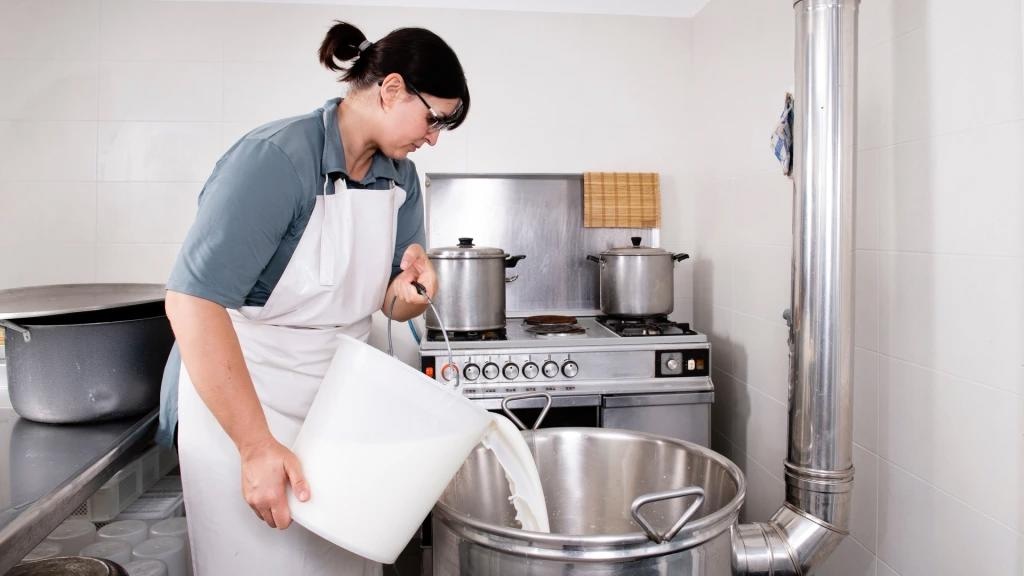Reviewed by Danielle Ellis, B.Sc.Aug 16 2023
With the use of DNA analysis, researchers examined the microbes that exist at various stages of the mozzarella-making process at different dairies. A majority of the bacteria were either Streptococcus or Lactobacillus, but at a smaller dairy, more minor bacterial families could be seen.

Image Credit: Shutterstock.com
The common similarity of the microbiota that was involved between dairies proves that, in spite of minor differences among producers, the same microbes produce the mozzarella.
Mozzarella is far more than just a pizza topping. For around 30 years, a unique Italian cheese, buffalo mozzarella from Campania has been known to be a delicacy and protected under EU law. However, what makes this mozzarella so unique? There are simple ingredients: rennet, water buffalo milk, and natural whey starter, processed with the use of brine and fresh water.
Nevertheless, the natural whey starter comprises microbes that are important to making the mozzarella. Researchers from Italy made use of high-throughput 16S rRNA amplicon sequencing, which offers an elaborate picture of what microbes exist and in what ratios, to comprehend how microbes process mozzarella.
This study sheds light on the intricate interactions of microorganisms throughout the manufacturing process and fosters a deeper understanding of the craftsmanship behind this esteemed Italian cheese.”
Dr Alessia Levante, Study Lead Author, University of Parma
This study was published in Frontiers in Microbiology.
Mozzarella Under the Microscope
To qualify for protected designation of origin (PDO) status, buffalo mozzarella has to be produced as per a particular recipe. Pasteurized or raw water buffalo milk is heated and inoculated with a natural whey starter and rennet. This starter acidifies the curd quickly, in turn bringing it to the right pH and making it sufficiently stretchy to be molded.
The formed curds are ripened for around four hours until they attain the right pH when they turn into elastic and can be molded and stretched in boiling water. Then, these curds are hardened under running water and brined. Slight changes in this method make the difference among the products of various dairies.
To study the role of bacteria and if this changes between conventional dairies and more modern ones, Levante and her team chose two dairies in Campania that make mozzarella that qualifies for PDO status: one larger and with the use of more advanced technology, one smaller and with the more conventional processes. They collected samples of the natural whey starter, dairies’ milk, cheese curd before stretching, brine, and mozzarella.
While both dairies produced PDO mozzarella di bufala Campana, subtle variations, such as temperature and duration of processes, influenced the cheese’s microbial composition and potentially impacted organoleptic properties.”
Dr Alessia Levante, Study Lead Author, University of Parma
Bacteria Get a Pizza the Action
To conduct 16S rRNA amplicon gene sequencing, 19 samples were sufficiently concentrated. This functions by sequencing the DNA of a sample and amplifying certain areas of a highly variable gene, then employing this data to find the microbe species existing and the proportions they appear in.
The team found that the pasteurized milk used by the more advanced dairy included fewer microbes and species of microbes in the production compared to the thermized milk utilized by the more conventional dairy, but that the brine samples were as rich in species as the processed cheese samples. A small number of species build and take over at the time of the curd process.
By microbes from the Streptococcus and Lactobacillus genera, both samples were dominated. The natural whey starter from the more conventional dairy had an approximately equal quantity of both, whereas the more advanced dairy employed a natural whey starter dominated by Streptococcus. Particular species within every genus were specific to each dairy. Following curdling, in both samples’ sets, Streptococcus drops and Lactobacillus increases, likely because the thermal stress generated by the stretching process has been eliminated.
The brine also provides a microbial diversity source: it inoculates the exterior layer of the cheese with new microbes as it gets into contact with the cheese surface. But, not all the microbes in the brine seem to be present in the cheese. This could be a result of they are not fit to live on the cheese, or because they form later in the shelf-life of cheese after the cheese samples were taken. In spite of the huge number of microbes species available in the milk and the brine, it seems that the microbial makeup of mozzarella is the most influenced by the natural whey starter.
We are planning a larger project to investigate more deeply the role of raw buffalo’s milk in defining the microbiota. This study’s scope was limited to two dairies and a specific sampling size. To provide more comprehensive insights into the microbial intricacies of traditional food production, future research aims to encompass a larger number of producers and manufacturing days.”
Dr Alessia Levante, Study Lead Author, University of Parma
Source:
Journal reference:
Levante, A., et al. (2023) The microbiota of Mozzarella di Bufala Campana PDO cheese: a study across the manufacturing process. Frontiers in Microbiology. doi.org/10.3389/fmicb.2023.1196879